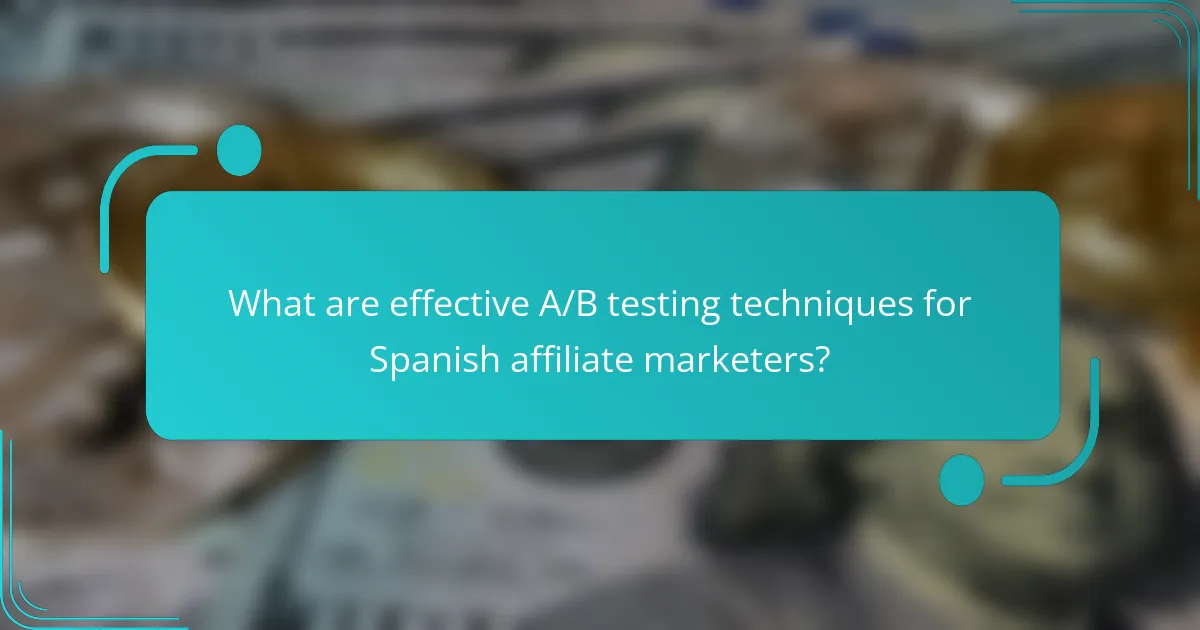Effective A/B testing techniques are essential for Spanish affiliate marketers aiming to enhance their performance and conversion rates. By systematically comparing variations of marketing elements, these marketers can make informed, data-driven decisions that resonate with their target audience across Spain and other Spanish-speaking regions.

What are effective A/B testing techniques for Spanish affiliate marketers?
Effective A/B testing techniques for Spanish affiliate marketers involve systematic methods to compare variations of marketing elements, optimizing performance and conversion rates. By utilizing these techniques, marketers can make data-driven decisions that resonate with their target audience in Spain and other Spanish-speaking regions.
Multivariate testing
Multivariate testing allows marketers to assess multiple variables simultaneously, such as headlines, images, and call-to-action buttons. This technique helps identify the best combination of elements that drive conversions. For example, testing three different headlines with two images can yield insights into which combination performs best.
When implementing multivariate tests, ensure that your sample size is large enough to achieve statistically significant results. A common pitfall is testing too many variations at once, which can dilute the data and lead to inconclusive outcomes.
Split URL testing
Split URL testing involves creating separate URLs for different versions of a webpage to evaluate their performance. This method is particularly useful for significant changes, such as a complete redesign or a new layout. For instance, you might direct half of your traffic to the original URL and the other half to the new design.
Keep in mind that split URL testing may require more resources and time to set up compared to traditional A/B testing. However, it can provide deeper insights into user behavior and preferences, especially when targeting Spanish-speaking audiences with localized content.
Sequential testing
Sequential testing is a method where variations are tested one after the other rather than simultaneously. This approach can be beneficial for understanding how changes impact user behavior over time. For example, you might first test a new headline, then follow up with a different image based on the results.
While sequential testing can provide clear insights, it may take longer to reach conclusions. Be cautious of external factors that could influence results during the testing period, such as seasonal trends or marketing campaigns targeting Spanish-speaking consumers.
Personalization strategies
Personalization strategies involve tailoring content and offers to individual users based on their preferences and behaviors. This can significantly enhance user engagement and conversion rates. For instance, using data from previous interactions, you can present personalized product recommendations to Spanish-speaking visitors.
To implement effective personalization, leverage user data responsibly and ensure compliance with local regulations, such as GDPR. Avoid over-personalization, which can lead to a negative user experience if users feel their privacy is compromised.
Mobile optimization
Mobile optimization is crucial for Spanish affiliate marketers, as a significant portion of users access content via mobile devices. Ensure that your A/B tests include mobile-friendly designs and layouts that cater to this audience. For example, test different button sizes or layouts to see which performs better on smartphones.
Monitor mobile performance metrics closely, such as load times and user engagement rates. A common mistake is neglecting mobile users during testing, which can skew results and lead to missed opportunities in the growing mobile market among Spanish-speaking consumers.

How can Spanish affiliate marketers implement A/B testing?
Spanish affiliate marketers can implement A/B testing by systematically comparing two versions of a webpage or marketing asset to determine which performs better. This process involves making data-driven decisions based on user interactions and preferences, ultimately enhancing conversion rates and ROI.
Define clear objectives
Establishing clear objectives is crucial for effective A/B testing. Marketers should identify specific goals, such as increasing click-through rates, improving conversion rates, or boosting engagement levels. For instance, if the aim is to enhance sales, focus on metrics like the number of completed purchases or average order value.
Once objectives are set, they should be measurable and time-bound. This helps in evaluating the success of the A/B tests and making informed adjustments based on the results.
Segment target audience
Segmenting the target audience allows marketers to tailor A/B tests to specific user groups. By dividing the audience based on demographics, behavior, or preferences, marketers can create more relevant variations. For example, a Spanish affiliate marketer might test different messaging for younger audiences versus older ones.
Effective segmentation can lead to more accurate insights, as different groups may respond uniquely to changes. Using tools like Google Analytics can help identify key segments and their characteristics.
Choose appropriate tools
Selecting the right tools is essential for executing A/B tests efficiently. Popular platforms such as Optimizely, VWO, and Google Optimize offer user-friendly interfaces and robust analytics capabilities. These tools enable marketers to create variations, track performance, and analyze results seamlessly.
When choosing a tool, consider factors like ease of use, integration with existing systems, and cost. Many tools offer free trials, allowing marketers to test their features before committing to a subscription.

What tools are best for A/B testing in Spain?
For Spanish affiliate marketers, effective A/B testing tools include Google Optimize, Optimizely, and VWO. These platforms provide user-friendly interfaces and robust features tailored to optimize conversion rates.
Google Optimize
Google Optimize is a free tool that integrates seamlessly with Google Analytics, making it a popular choice for marketers in Spain. It allows users to create and run A/B tests, multivariate tests, and redirect tests easily.
To get started, simply link your Google Optimize account to your Google Analytics property. You can then create experiments targeting specific segments of your audience, which is crucial for understanding local preferences.
One common pitfall is not setting clear objectives for your tests. Always define what success looks like, whether it’s increased clicks or higher sales conversions.
Optimizely
Optimizely is a powerful A/B testing platform that offers advanced features such as personalization and multivariate testing. It is particularly useful for larger businesses looking to optimize user experiences across multiple channels.
With Optimizely, you can easily create experiments using a visual editor, which requires no coding skills. This makes it accessible for marketers who may not have a technical background.
However, Optimizely can be more expensive than other options, so it’s essential to weigh its benefits against your budget. Consider starting with a trial to assess its fit for your needs.
VWO
VWO (Visual Website Optimizer) is another robust A/B testing tool that provides a comprehensive suite of conversion optimization features. Its visual editor allows marketers to create tests without needing technical expertise.
VWO stands out for its heatmaps and session recordings, which help you understand user behavior on your site. This insight can inform your A/B testing strategy, especially when targeting the Spanish market.
Be cautious of running too many tests simultaneously, as this can dilute your results. Focus on a few key experiments to ensure you gather actionable data that drives improvements.

What metrics should Spanish affiliate marketers track?
Spanish affiliate marketers should focus on key performance metrics that directly impact their campaigns. Tracking conversion rate, click-through rate, and engagement metrics will provide valuable insights into the effectiveness of their strategies.
Conversion rate
The conversion rate measures the percentage of visitors who complete a desired action, such as making a purchase or signing up for a newsletter. For Spanish affiliate marketers, a typical conversion rate can range from 1% to 5%, depending on the niche and the quality of traffic. Regularly analyzing this metric helps identify which campaigns are effective and which need adjustment.
To improve conversion rates, consider A/B testing different landing pages, offers, or calls to action. Small changes, like altering button colors or headlines, can significantly impact user behavior.
Click-through rate
Click-through rate (CTR) indicates the percentage of users who click on a specific link compared to the total number of users who view a page, email, or advertisement. A healthy CTR for affiliate marketing typically falls between 2% and 10%. Monitoring this metric helps gauge the effectiveness of your ad copy and targeting.
To enhance CTR, use compelling headlines and clear, concise calls to action. Testing various ad placements and formats can also reveal which combinations yield the highest engagement.
Engagement metrics
Engagement metrics encompass various indicators of how users interact with your content, including time spent on site, pages per session, and bounce rate. High engagement often correlates with higher conversion rates, making it essential for Spanish affiliate marketers to track these figures closely.
To boost engagement, create high-quality, relevant content that resonates with your audience. Regularly review analytics to identify content that performs well and replicate its success in future campaigns.

What are common mistakes in A/B testing?
Common mistakes in A/B testing can lead to inaccurate results and wasted resources. Understanding these pitfalls helps Spanish affiliate marketers optimize their campaigns effectively.
Insufficient sample size
Using an insufficient sample size can skew A/B test results, making it difficult to draw reliable conclusions. A small group may not represent the broader audience, leading to misleading insights.
To avoid this mistake, aim for a sample size that reflects your target market. Generally, a few hundred participants per variant is a good starting point, but larger audiences yield more reliable data.
Testing too many variables
Testing multiple variables simultaneously can complicate the analysis and obscure which change is responsible for any observed effect. This approach can result in inconclusive or contradictory results.
Instead, focus on one variable at a time, such as headlines or call-to-action buttons. This method allows for clearer insights and easier identification of what works best for your audience.
Ignoring statistical significance
Ignoring statistical significance can lead to decisions based on random chance rather than actual performance differences. Without proper analysis, you may implement changes that do not improve conversion rates.
Use statistical tools to determine if your results are significant. A common threshold is a p-value of less than 0.05, indicating that there is a less than 5% probability that the observed differences are due to chance.